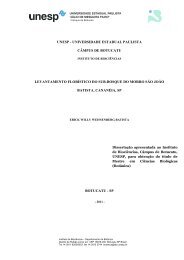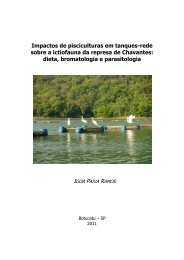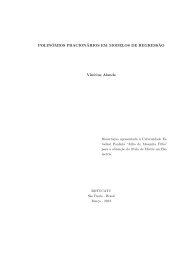Visualizar Tese - Instituto de Biociências - Unesp
Visualizar Tese - Instituto de Biociências - Unesp
Visualizar Tese - Instituto de Biociências - Unesp
You also want an ePaper? Increase the reach of your titles
YUMPU automatically turns print PDFs into web optimized ePapers that Google loves.
Four years of study were done and in the three first ones (1998,1999<br />
and 2000) 30.201 samples were shown in the fish landings belonging to 71 species of<br />
fishes being these grouped into 19 families, 47 genera and four or<strong>de</strong>rs<br />
(Characiformes, Siluriformes, Gymnotiformes and Perciformes). Of all these species<br />
the ten found in more abundance were: The corvine (Plagioscion squamosissimus),<br />
the taguara (Schizodon nasutus), the acarajéu (Satanoperca pappaterra), the pacuprata<br />
(Metynnis mola), the piranha (Serrasalmus maculatus), the mandi (Pimelodus<br />
maculatus), the caborja (Hoplosternum littorale), the cascudo-amazonas<br />
(Pterygoplichthys anisitsi), the traíra (Hoplias malabaricus) and the cascudos claros<br />
(Hypostomus sp.1), representing 76,23% from the total samples.<br />
Still between these ten species, the exotic/introduced represented half<br />
of the most abundant ones, being P. squamosissimus,<br />
S. pappaterra, M. mola,<br />
H.littorale and P. anisitsi. In the last year of work in 2006, only 2.486 samples were<br />
shown, also including a new species that was found : the porquinho (Geophagus<br />
proximus), making it 72 species and 48 registered genera in the four years of study<br />
totalizing 32.687 shown species.<br />
Within the four years, the introduced species P. squamosissimus lea<strong>de</strong>d<br />
the ranking in numbers of individual and biomass; and in this last year it was<br />
responsible alone for 47% of the fish landings.<br />
Capture data per unit of effort and the ecological attributes show a very<br />
critical and worrying situation, for it’s clearly noticed that there was a drastic <strong>de</strong>crease<br />
in the number of species, as well as in the number and in the biomass of the last<br />
collected samples in the last year of study.<br />
The most plausible hypothesis to this serious situation would be the<br />
great number of exotic/introduced species which are competing with the native ones,
















